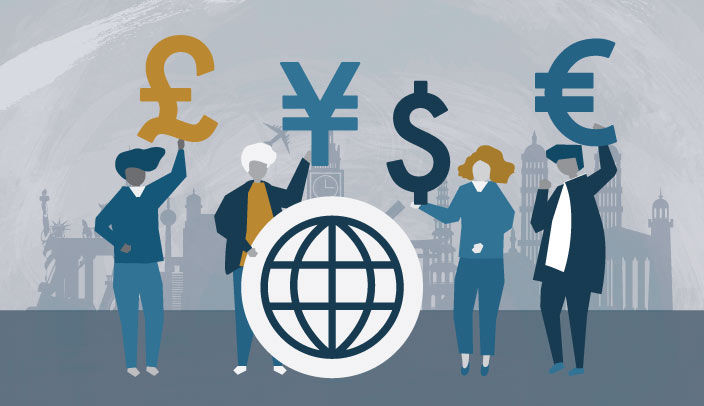
Dollar dominance
For most of the 20th century, the US Dollar was the most dominant currency in the world, due to the fact that the US controlled much of global trade and most of the transnational organisations governing it, such as the World Bank and the International Monetary Fund (IMF).
This dominance continues now, with the US using its clout to drive socio-political goals by imposing sanctions and excluding non-compliant governments and organisations from the global trade and economic systems where the US is dominant. The best example of this is the sanctions on Russia and certain Russian citizens due to their invasion of Ukraine in the hope of influencing their ability to conduct the war.
Needless to say, this has led to complaints from sanctioned and excluded entities and governments. The main argument being that the US is aiming to stifle international political diversity by suppressing forms of government that do not conform to a traditional definition of democracy (especially China’s one-party state system) and economic systems that are not driven by free market neoliberalism. This, many argue, sometimes impedes on local traditions and culture.
See also: Manage your currency risk with our innovative tools
Although crypto has been touted as a possible candidate to unseat the US Dollar, it won’t be feasible in the immediate future due to technical instability and the volatility of prices/rate movements. A successful reserve currency will need to meet high standards of stability, useability or adoption and as a store of value.
To mitigate the effects of having a single reserve currency dominating world trade, arguments are being made for a multipolar currency system. A multipolar currency system is one in which several currencies dominate the world economy, each holding significant sway in their respective regions.
The most prominent of these are the Euro (EUR), the Chinese Yuan (CNY), the Japanese Yen (JPY) and the British Pound (GBP).
The Euro
The European Union (EU), with its integrated economy is a major market for raw materials and exporter of industrial products in the Eurasia region. At present, it comprises 27 member states, each with their own unique economic needs and strengths.
The EU is considered to be one of the most politically and economically stable regions in the world. This currency is therefore seen as a safe-haven asset by investors.
The main drawback of the Euro is the lack of economic and financial integration with their less developed (or developing country) trading partners. There is not much institutional support for developing countries, for example the Eurozone countries are not able to provide loans to most countries in Sub-Saharan Africa or South Asia due mainly to a lack of synergy between their banking systems.
The Chinese Yuan
The Chinese economy is the second largest economy in the world and has always been export driven (at least for most of the post-world-war era). To fuel this growth, the country is also a major importer of raw materials, especially crude oil and precious metals. These are mainly priced and purchased in USD at present.
The size and scope of China’s imports and exports makes it one of the most important economic players in global markets. Its size and number of trading partners places the Chinese Yuan in a very suitable position as a regional currency with increasing demand.
The main drawback of using the Yuan is the fact that China has a planned economy and sometimes exerts significant political influence in its currency markets. This can have the impact of distorting prices and hinder the flow of goods and services internationally (due mainly to differing economic systems and infrastructure).
The Japanese Yen
The Yen, along with the CNY are perhaps the most dominant currencies in the East Asian region. The JPY has long been considered a safe-haven asset due also to the stable Japanese economy. Japan has been seen as a developed economy since the 1990s with low interest rates and low borrowing costs. This makes the JPY attractive as a funding currency – whereby traders and investors would borrow JPY to purchase other assets such stocks and bonds (either in Japan or in the South Asian region).
The main problem with the JPY as reserve currency is the artificially low yields on JPY bonds. The currency is purposefully kept weak by the Japanese Central Bank (BOJ). Government interference in the money markets may cause instability in the long run, especially during an economic downturn.
Read more: Why is Japan not raising interest rates?
A potential BRICS common currency
BRICS consists of some of the fastest growing economies (China, Brazil, etc.) and this list is looking to expand as BRICS+, with the inclusion of other strong emerging economies (Saudi Arabia, the Arabic Emirates, amongst others). This group can potentially control a very large part of global trade and will have immense economic and political influence. A common currency for the BRICS group of countries, while still a significantly long way off and with many obstacles to overcome, can potentially be a disruptor to USD dominance.
The first and most prominent obstacle is the heterogeneous nature of their members – many of whose economies are on different stages of development, meaning their economic infrastructures and superstructures vary in terms of capacity, integrity, and interoperability. It will remain to be seen how (or if) BRICS members are able to coordinate their economies and socio-political systems for integration and collective actions.
See also: How currency exchange rates are determined
Diversification is essential
While the sheer size and scope of USD influence ensures its dominance is far from over, the main characteristic of recent developments in the forex markets has been increased competition with the USD. This can reasonably be assumed to continue and increase in intensity in the near future, especially as rising economic powers such as China and the BRICS group of countries start to exert their influence in their respective regions.
Diversifying away from the USD and traditional safe-haven currencies gives you the opportunity to take advantage of short-term rate movements in both safe-haven and exotic currencies, like the ones mentioned here.
Contribution by Justin Fortuin
